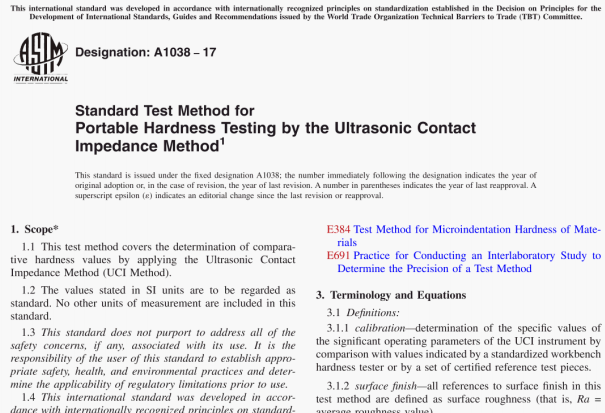ASTM A1038:17 pdf download.Standard Test Method for Portable Hardness Testing by the Ultrasonic Contact lmpedance Method.
5.3.5 The frequency shift is a function of the indentation size of a defined indenter, for example, a Vickers diamond, at a given modulus of elasticity of the measurement system.
5.3.6 Eq 3 describes the basic relation in comparison to the
definition of the Vickers hardness value: zf= Frequency shift,
A = indentation area, Eeff•= effective elastic modulus (contains
the elastic constants of both the indenter and the test piece), HV
= Vickers hardness value, F = Force applied in the hardness
test.
5.4 The Influence of the Elastic Constants—As can he seen in Eq 3, the frequency shift not only depends on the size of the contact area but also on the elastic moduli of the materials in contact. To allow for differences in Young’s modulus, the instrument has to be calibrated for different groups of materials. After calibration, the UCI method can be applied to all materials, which have the corresponding Young’s modulus.
5.4.1 As manufactured, the UCI instrument usually has been calibrated on non-alloyed and low-alloyed steel, that is, cciii- tied hardness reference blocks according to Test Method E384. Besides this, some instruments may he calibrated quickly, also at the test site, for metals such as high-alloyed steels, aluminum or titanium.
6. Calibration to Other Materials
6.1 A test piece of the particular material is needed. The hardness value should then be determined with a standardized workbench hardness tester like one for Vickers, Brinell or Rockwell according to Test Methods and Definitions A370. It is recommended to take at least five readings and calculate the average hardness value. Now carry out a set of at least five single UCI measurements on your test material according to instructions in 10.6, adjust the displayed average value to the before measured hardness of the material and thus find the calibration value which is necessary for further measurements on this particular material in the desired hardness scale and range.
6.1.1 Some instruments allow storing all calibration data and adjustment parameters for hardness testing of different materials. They can be recalled to the instrument as needed.
7. Comparison with Other Hardness riestilig Methods
7.1 As opposed to conventional low load hardness testers, the UCI instruments do not evaluate the indentation size microscopically but electronically according to the UCI method. The UCI method yields comparative hardness measurements when considering the dependency on the elastic modulus of the test piece.
ASTM A1038:17 pdf download
